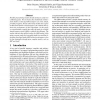Free Online Productivity Tools
i2Speak
i2Symbol
i2OCR
iTex2Img
iWeb2Print
iWeb2Shot
i2Type
iPdf2Split
iPdf2Merge
i2Bopomofo
i2Arabic
i2Style
i2Image
i2PDF
iLatex2Rtf
Sci2ools
115
click to vote
IPPS
1999
IEEE
1999
IEEE
Experimental Evaluation of QSM, a Simple Shared-Memory Model
Parallel programming models should attempt to satisfy two conflicting goals. On one hand, they should hide architectural details so that algorithm designers can write simple, portable programs. On the other hand, models must expose architectural details so that designers can evaluate and optimize the performance of their algorithms. In this paper, we experimentally examine the trade-offs made by a simple shared-memory model, QSM, to address this dilemma. The results indicate that analysis under the QSM model yields quite accurate results for reasonable input sizes and that algorithms developed under QSM achieve performance close to that obtainable through more complex models, such as BSP and LogP.
Architectural Details | Distributed And Parallel Computing | IPPS 1999 | QSM Achieve Performance | QSM Model Yields |
Related Content
| Added | 03 Aug 2010 |
| Updated | 03 Aug 2010 |
| Type | Conference |
| Year | 1999 |
| Where | IPPS |
| Authors | Brian Grayson, Michael Dahlin, Vijaya Ramachandran |
Comments (0)

